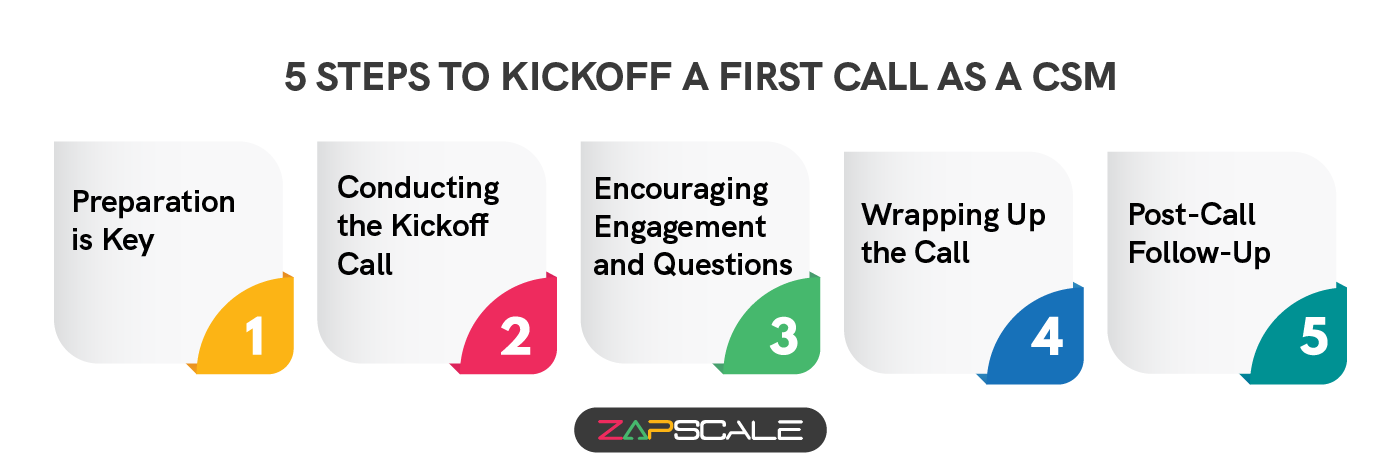CATEGORY > Customer Success Management
How to Run Your First Customer Kickoff Call as a Customer Success Manager

Introduction
Running your first customer kickoff call as a customer success manager is an exciting opportunity to set the stage for a successful partnership between your company and your new customer.
This initial interaction is crucial because it lays the foundation for a long-term relationship, sets expectations, and ensures that both parties are aligned on goals and objectives.
Here's a comprehensive guide on effectively running your first customer kickoff call.

Preparation Is Key
Before the call, thorough preparation is essential.
Understanding your customer’s needs, goals, and challenges is crucial to provide value from the very start.
1. Research The Customer
a. Understand Their Business
Research your customer’s industry, market position, and business model. Understanding the customer’s pain points and objectives will help you tailor the conversation to their specific needs.
b. Know Your Stakeholders
Identify the key stakeholders who will be present on the call. Familiarize yourself with their roles and responsibilities to address their specific concerns.
c. Review Past Interactions
If there have been previous interactions with the sales team or any other department, review the notes to understand what has been discussed and promised.
2. Prepare Your Agenda
a. Outline Key Topics
Prepare a structured agenda that covers all critical topics, including introductions, goals and objectives, product overview, implementation timeline, and next steps.
b. Share The Agenda
Send the agenda to the customer before the call to ensure they know what to expect and can prepare any questions or topics they want to discuss.
3. Set Up Your Tools
a. Choose The Right Platform
Ensure you have a reliable video conferencing platform set up for the call. Familiarize yourself with its features to facilitate smooth communication.
b. Test Your Technology
Test your microphone, camera, and internet connection to avoid technical issues during the call.
Conducting The Kickoff Call
The kickoff call should be a balance of setting the right tone, building rapport, and diving into the specifics of how you will work together.
1. Introduction And Building Rapport
a. Start With Warm Greetings
Begin the call with friendly introductions. Make the participants feel comfortable by expressing enthusiasm about working with them.
b. Share Background Information
Briefly introduce yourself and your role as a CSM. Provide an overview of your experience and expertise in helping customers achieve their goals.

2. Discuss Goals And Objectives
a. Listen Actively
Encourage the customer to share their goals, expectations, and any challenges they foresee.
Listen actively and take notes to show you value their input.
b. Align On Objectives
Collaboratively discuss and align specific objectives and key performance indicators that define success for the customer.
3. Product Overview And Value Proposition
a. Highlight Key Features
Provide a brief overview of your product or service, focusing on the features that align with the customer's goals.
b. Demonstrate Value
Emphasize how your solution addresses the customer's pain points and contributes to achieving their objectives.
4. Implementation Plan
a. Outline The Process
Present a clear and concise implementation plan, including timelines, milestones, and responsibilities.
b. Set Realistic Expectations
Discuss potential challenges and how you plan to address them. Setting realistic expectations helps build trust and credibility.
Encouraging Engagement And Questions
1. Encourage Questions
a. Create An Open Environment
Foster an environment where customers feel comfortable asking questions and sharing concerns.
b. Address Questions Promptly
Respond to questions and concerns promptly and accurately.
If you don't have an immediate answer, assure them that you will follow up with the necessary information.
2. Foster Collaboration
a. Involve All Participants
Encourage participation from all stakeholders on the call, ensuring everyone feels heard and valued.
b. Discuss Collaboration Tools
Introduce any collaboration tools or platforms that will be used for ongoing communication and project management.
Wrapping Up The Call
Concluding the kickoff call with clear next steps ensures everyone is on the same page moving forward.
1. Summarize Key Points
a. Recap The Discussion
Summarize the key points discussed during the call, including goals, objectives, timelines, and responsibilities.
b. Confirm Action Items
Clearly outline the next steps and action items for both parties. Ensure everyone understands their roles and responsibilities.
2. Schedule Follow -Up Meetings
a. Set Up Regular Check-Ins
Schedule regular check-in meetings to monitor progress, address any issues, and keep the project on track.
b. Provide Contact Information
Share your contact information and encourage customers to reach out with any questions or concerns between meetings.
Post-Call Follow Up
The follow-up is just as important as the call itself. It demonstrates your commitment to the customer's success.
1. Send A Follow-Up Email
a. Thank The Participants
Send a thank-you email to all participants, expressing appreciation for their time and input.
b. Share Meetings Notes
Provide a summary of the meeting, including key takeaways, action items, and any additional resources discussed during the call.
2. Maintain Open Communication
a. Stay Accessible
Remain accessible to the customer and proactively reach out to address any emerging needs or concerns.
b. Monitor Progress
Keep track of the customer's progress and celebrate milestones together, reinforcing the partnership.
Conclusion
By thoroughly preparing, actively engaging, and building strong relationships, you can ensure your company and the customer are aligned on goals and expectations.
This initial call is about sharing information and fostering a collaborative environment where both parties feel valued and supported.
Remember, the kickoff call is just the beginning.
Regular communication, ongoing support, and a proactive approach are key to maintaining a strong and successful relationship with your customers.
By leveraging the insights gained during the kickoff call and continuously adapting to your customer's evolving needs, you can drive customer satisfaction, retention, and ultimately, long-term success for both parties.
In summary, treat the kickoff call as an opportunity to showcase your commitment to your customer's success and lay the foundation for a lasting partnership.
By doing so, you’ll not only meet but exceed customer expectations, solidifying your role as a trusted advisor and advocate in their journey to success.
ABOUT THE AUTHOR
Popular from Customer Success Management
Quality Content,
Straight To Your Inbox!
Subscribe for the latest blogs, podcasts, webinars, and events!

Write a Blog
If you have experience in CS and
a flair for writing, we’d love to
feature you.
Write to us on
hello@zapscale.com





